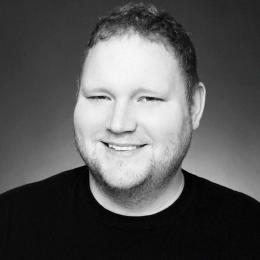Under My Skin: The New Frontier Of Digital Implants
Steven Melendez June 11, 2016
Tim Shank can guarantee he’ll never leave home without his keys. Why? His house keys are located inside his body.
Shank, the president of the Minneapolis futurist group TwinCities+, has a chip installed in his hand that can communicate electronically with his front door and tell it to unlock itself. His wife has one, too.
“You have mental checklists as you’re coming and going out of your home,” Shank says. “One of those things is my wallet, keys, all those things I have with me. Once you start to eliminate all those things, you start to see all the mind space it actually clears not to have to worry about them.”
In fact, Shank has several chips in his hand, including a near field communication (NFC) chip like the ones used in Apple Pay and similar systems, which stores a virtual business card with contact information for TwinCities+. “[For] people with Android phones, I can just tap their phone with my hand, right over the chip, and it will send that information to their phone,” he says. In the past, he’s also used a chip to store a bitcoin wallet.
Shank is one of a growing number of “biohackers” who implant hardware ranging from microchips to magnets inside their bodies.

Some biohackers use their implants in experimental art projects. Others who have disabilities or medical conditions use them to improve their quality of life, while still others use the chips to extend the limits of human perception. Shank, for instance, has experimented with a portable distance sensor that vibrates a magnet in his hand; it’s like a sonar system that lets him sense how far away obstacles are. He also considered installing a chip that would track his body temperature. But not every use case is so ambitious—for some, the chips are merely convenient ways to store data and unlock doors.
Experts sometimes caution that the long-term health risks of the practice are still unknown. But many biohackers claim that, if done right, implants can be no more dangerous than getting a piercing or tattoo. In fact, professional body piercers are frequently the ones tasked with installing these implants, given that they possess the training and sterilization equipment necessary to break people’s skin safely.
“When you talk about things like risk, things like putting it in your body, the reality is the risk of having one of these installed is extremely low—it’s even lower than an ear piercing,” claims Amal Graafstra, the founder of Dangerous Things, a biohacking supply company.

Graafstra, who is also the author of the book RFID Toys, says he first had an RFID chip installed in his hand in 2005, which allowed him to unlock doors without a key. When the maker movement took off a few years later, and as more hackers began to explore what they could put inside their bodies, he founded Dangerous Things with the aim of ensuring these procedures were done safely.
“I decided maybe it’s time to wrap a business model around this and make sure that the things people are trying to put in their bodies are safe,” he says. The company works with a network of trained body piercers and offers online manuals and videos for piercers looking to get up to speed on the biohacking movement.
At present, these chips are capable of verifying users’ identities and opening doors. And according to Graafstra, a next-generation chip will have enough on-board cryptographic power to potentially work with credit card terminals securely.
“The technology is there—we can definitely talk to payment terminals with it—but we don’t have the agreements in place with banks [and companies like] MasterCard to make that happen,” he says.
Paying for goods with an implantable chip might sound unusual for consumers and risky for banks, but Graafstra thinks the practice will one day become commonplace. He points to a survey released by Visa last year that found that 25% of Australians are “at least slightly interested” in paying for purchases through a chip implanted in their bodies.
“It’s on the minds of people,” he says. “It just needs to be brought to fruition.”
Other implantable technology has more of an aesthetic focus: Pittsburgh biohacking company Grindhouse Wetware offers a below-the-skin, star-shaped array of LED lights called Northstar. While the product was inspired by the on-board lamps of a device called Circadia that Grindhouse founder Tim Cannon implanted to send his body temperature to a smartphone, the commercially available Northstar features only the lights and is designed to resemble natural bioluminescence.

“This particular device is mainly aesthetic,” says Grindhouse spokesman Ryan O’Shea. “It can backlight tattoos or be used in any kind of interpretive dance, or artists can use it in various ways.”
The lights activate in the presence of a magnetic field—one that is often provided by magnets already implanted in the same user’s fingertips. Which brings up another increasingly common piece of bio-hardware: magnetic finger implants. Hackers say these small magnets allow users to sense the presence of electromagnetic fields, to diagnose electrical problems like faulty wiring, and even to pull small metal objects like paper clips and bottle caps toward you, making you into something of a low-rent Magneto. Despite the power of these implants, they’re fortunately not strong enough to trip metal detectors, wipe hard drives, or interfere with MRI scans.

“Most [Northstar clients] already have the magnets,” says Zack Watson, a piercer who installs implants for Grindhouse. “The magnets are kind of like a baby step into the heavy mod community. It’s not so much visible as it is modifying the body to get that magnetic vision, and then the byproduct is that you’re able to activate the implant.”
According to O’Shea, a second-generation Northstar will include a Bluetooth transmitter and gesture-recognition sensors, which will let it communicate with a smartphone to control Internet of Things-type technology. That’s not the only reason many early adopters may eventually choose to upgrade their implants. Another has to do with the limited battery life.
“[The device] will die, much like a pacemaker will die,” he says. “When a pacemaker does die, it is removed in a procedure and is completely replaced with a new unit. That is similar to what will happen with Northstar.”
Luckily for users, the Northstar can be inserted or replaced in about 15 minutes by a skilled piercer, says O’Shea.
“It’s just a small incision, usually in the side of the hand,” he adds. “The skin is separated from the hand there, and the device is just inserted, and the skin is stitched up.”

As long as they’re inserted properly, the implants leave minimal scarring, says Watson. He has magnets in his hand that let him do “little parlor tricks” and pick up needles while he works. “My kids are convinced I have a magic finger,” he says. Meanwhile, an RFID chip in his hand lets him unlock his phone and automatically load his Instagram portfolio for potential customers to see.
“My phone has a reader in it, and you’re able to use that reader to scan my hand,” Watson says. “It’s a cool way to show off your work.”
Grindhouse is also working on an enhanced version of the Circadia device that tracks founder Cannon’s body temperature. Cannon says that in the future, Circadia could potentially track other vital signs like blood oxygen, heart rate, and blood glucose. That, however, could pose tricky regulatory challenges for the company, he acknowledges, potentially bringing the device closer to medical sensors regulated by the Food and Drug Administration.
The line between medical devices and personal electronics has already begun to grow fuzzier. In recent months, the FDA has tentatively said it doesn’t want to impose the same red tape on “low-risk devices” like fitness trackers that it would impose on medical equipment. Even the White House has weighed in, saying it’s exploring options to bridge the gap between expensive, regulated hearing aids and cheaper amplification or tracking tools technically not certified for medical use.
Grindhouse’s foray into blood sugar tracking would follow projects like the Open Artificial Pancreas System, which lets diabetes patients build their own automatic blood sugar regulation tools using a Raspberry Pi computer to talk to an insulin pump and a glucose monitor. Some in the biohacking community have already used custom-built tools to overcome other disabilities or limitations. Artist Neil Harbisson, for instance, who was born color blind, used an implanted antenna to translate colors into audible sounds.
O’Shea says Grindhouse isn’t at all opposed to regulation: The company already does extensive testing to make sure its products are safe and won’t break down in the body—not even after physical trauma—and would welcome regulations that ensure people don’t unwittingly put something toxic or otherwise dangerous into their bodies.
“With Northstar right now, if there’s something that you encounter that’s going to destroy the Northstar in your body, you’re probably already dead at that point,” he asserts.
What the company doesn’t want to see, O’Shea says, is the same full-on regulation of medical devices brought to bear on implantable products like the Circadia, which could make them impractical for startups and hackers to develop and prohibitively expensive for many potential users.

“The issue with FDA regulations is not only does it take an expensive amount of time and money that many bootstrapped companies do not have access to, but it also limits the people who can do these procedures,” O’Shea says. “We want these augmentative devices to be open to as many people as possible for as cheap as possible, so there aren’t people who can’t have access to this technology.”
In the meantime, with implants essentially flying under the regulatory radar, hackers are exploring how they can use the devices to manipulate and receive input from the world around them without a great deal of scrutiny from government bodies.
One of these hackers is artist, dancer, and self-proclaimed cyborg Moon Ribas, who has an Internet-connected implant in her arm that vibrates to alert her to earthquakes around the world—information she can incorporate into her choreographed routines.
She hopes to add additional, more precise implants that would communicate the continent where the earthquake took place, and perhaps another that reports quakes on the moon.
“This would allow me to be here and be in space in the same time,” she says.
Ribas is also working on a commercial implant that would let users feel a vibration when they face due north, potentially training them to develop a directional sense similar to some animals. That’s a far cry from Tim Shank’s comparatively unambitious door-unlocking implant.
“I like things that are related to nature, space, or animals,” she says. “Everyone has his own interests—it’s just that it doesn’t fulfill me as much to think about having an implant to open a door.”
(75)



